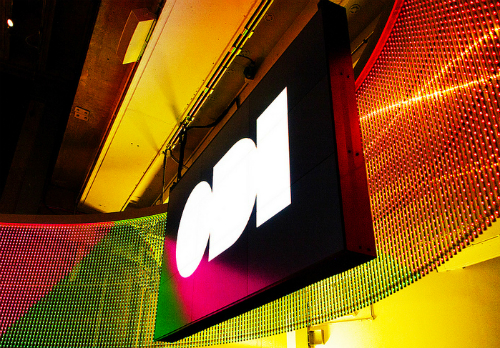 |
| Open Data Institute Annual Summit/ODI © 2013/CC BY-NC-SA 2.0 |
Next week is Web Science Research Week. I’m working on a team project: Using Linked Data to Record and Expose Linked Resources. This is the brief:
Critical to the research is the collection, curation and organisation of related work, examples and business cases that build the key evidence base upon which further work can be carried out scientifically – standing on the shoulders of giants. While an individual may be able to collate and organise references to other works, it is a much harder job to organise and expose multiple collections of resources at an organisational (and global) scale. This project aims to ask if linked data can help? The ODI uses several mechanism to collect links, references and citations, each suited to the demand of its project and individual preferences of those carrying out each project. These links and references represent a valuable resource not only to the organisation itself but also to the wider population, however organising and exposing these links in context with the reports, projects and work they relate to is a problem as yet unsolved. With several projects now complete, links and references have accumulated in Google Docs, Pinboard and Zotero and we want to find out if these references can be organised, given back context (where they have been used), interlinked (related links) and exposed. We believe linked data could hold the answer to these problems.
This week’s readings:
COMP6050 – Semantic Web for Web Science
- Daniele Nardi and Ronald J. Brachman, An Introduction to Description Logics, in Franz Baader, Diego Calvanese, Deborah L. McGuinness, Daniele Nardi and Peter F. Patel-Schneider (eds) The Description Logic Handbook: Theory, implementation and applications, Cambridge University Press, 2003, pp1-40
- F. Baader and W. Nutt, Basic Description Logics, in Franz Baader, Diego Calvanese, Deborah L. McGuinness, Daniele Nardi and Peter F. Patel-Schneider (eds) The Description Logic Handbook: Theory, implementation and applications, Cambridge University Press, 2003, pp47-100
- FOAF Worksheet
COMP6052 Social Networking Technology
- Wang, X. F., & Guanrong Chen Circuits and Systems Magazine, I. (n.d.). Complex networks: small-world, scale-free and beyond. Circuits and Systems Magazine, IEEE, 3(1).
- Borgatti, S.P. & Everett, M.G. (2006). A Graph-theoretic perspective on centrality. Social Networks. 28 (4). pp. 466–484.
- Watts, D. & Strogatz, S. (1998). Collective Dynamics of Small-World Networks. Collective Dynamics of Small-World Networks. 393. pp. 440–442.
- Easley, D. and Kleinberg, J. Networks Crowds and Markets. Cambridge University Press, 2010.
- Fung. A comprehensive overview of basic clustering algorithms. IEEE, June (2001)
- Schaeffer. Graph clustering. Computer Science Review (2007) vol. 1 (1) pp. 27-64
- Fjallstrom. Algorithms for graph partitioning: A survey. Linkoping Electronic Articles in Computer and Information Science (1998) vol. 3 (10)
- Huberman, Romero, Wu. Social networks that matter: Twitter under the microscope. First Monday (2009)
- McPherson, Smith-Lovin, Cook. Birds of a feather: Homophily in social networks. Annual review of sociology (2001)
- Dorwin Cartwright, Frank Harary, Structural balance: a generalization of Heider’s theory, Psychological Review, Volume 63, Issue 5, September 1956, Pages 277-293
- James A. Davis. Clustering and Structural Balance in Graphs. Human Relations May 1967 20: 181-187 [per HM – Hartley Library]
- Kossinets, G. and Watts, D. J. Empirical analysis of an evolving social network. Science (2006) vol. 311 (5757) pp. 88
- Kunegis J., Lommatzsch, A. and Bauckhage, C. The Slashdot Zoo: Mining a social network with negative edges. Proceedings of the 18th international conference on World wide web (2009) pp. 741-750
- Börner, K., Sanyal, S. & Vespignani, A. (2007). Network science B. Cronin (ed.). Annual Review of Information Science & Technology. 41. pp. 537–607.
- Ahmad, M. A., Keegan, B., Williams, D., Srivastava, J., & Contractor, N. (2011). Trust amongst rogues? A hypergraph approach for comparing clandestine trust networks in MMOGs. Proceedings of the 5th International AAAI Conference on Weblogs and Social Media, 10–17.
- Albert-László Barabási talk on Network Science at the Royal Society in 2010 (VIDEO)
RESM6003 – Qualitative Methods
- Blenkinsop, L. (2009) ‘The internet: virtual space’, in S. Barber and C. Peniston-Bird (eds) History Beyond the Text: A student’s guide to approaching alternative sources, pp. 122-135
- Dobson, M. (2009) ‘Letters’, in M. Dobson and B. Ziemann, Reading Primary Sources: The interpretation of texts from nineteenth- and twentieth-century history, pp. 57-73 [e-book]
- Roper, M. (2009) The Secret Battle: Emotional survival in the Great War, Manchester: Manchester University Press.
- Steven, S. (2002) ‘Making sense of letters and diaries’, History Matters: The U.S. Survey Course on the Web.
- Background reading on archives and source interpretation:
- Abrams, L. (2010) Oral History Theory, London: Routledge [D 16.11 ABR] (Review).
- Jordanova, L. (2012) The Look of the Past: Visual and Material Evidence in Historical Practice, Cambridge University Press.
- Tosh, J. (2006, 4th edn) The Pursuit of History: Aims, methods and new directions in the study of modern history, Pearson. [D 16.2 TOS] Ch. 3, ‘The Raw materials’ and Ch. 4, ‘Using the sources’ [e-book]
- Trouillot, M-R. (2004) Silencing the Past: Power and the production of history, Boston: Beacon Press